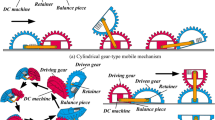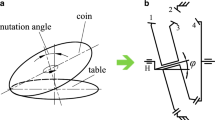Abstract
As one of the most important components in the micro in-pipe robot, the supporting and locking mechanism determines the working performance of the robot. In this paper, a new supporting and locking mechanism based on the non-circular gear compound transmission (SLM-NGCT) is proposed. According to the advanced mechanisms and differential geometry theory, transmission coordinates of the movement mechanism were established and the movement equations were derived. The influence factors and change rules of the displacement, velocity and acceleration of the movement mechanism were analyzed. Based on gear meshing theory and the cam theory, the mechanical characteristics of the flexible friction block of the movement mechanism were analyzed. A simulation model of SLM-NGCT was established and the comparison results between simulation and theoretical model show the correctness of the theoretical analysis and the feasibility of non-circular gear pairs instead of the cam mechanism. The study has guiding significance in the supporting and locking mechanism of micro in-pipe robot.
Similar content being viewed by others
Abbreviations
- S A :
-
Linear displacement
- S :
-
Reciprocating displacement
- F f1 :
-
Foundation frictional force
- L :
-
Length of flexible friction block
- H :
-
Width of flexible friction block
- B :
-
Height of flexible friction block
- a :
-
Long-axis of non-circular gear
References
Y. H. Wang and R. G. Zuo, Research status of micro in-pipe robot at home and abroad, J. of Machine Design, 12 (2010) 96–106.
Y. J. Yum et al., In-pipe micromachine locomotion via the iner-tial stepping principle, J. of Mechanical Science and Technology, 28 (8) (2014) 3237–3247.
M. Takahashi et al., The development of an in-pipe microrobot applying the motion of an earthworm, 5th International Symposium on Micro Machine and Human Science Proceedings (1994) 35.
A. Zagler and F. Pfeiffer, “MORITZ” a pipe crawler for tube junctions, IEEE International Conference on Robotics and Automation (2003) 2954–2959.
J. Lim et al., One pneumatic line based inchworm-like micro robot for half-inch pipe inspection, Mechatronics, 18 (7) (2008) 315–322.
Y. W. Zhang et al., Pipe-diameter adapting and adjusting mechanism of gas pipeline inspection robot, J. of Shanghai Jiaotong University, 16 (8) (2005) 685–688.
Y. Xue et al., Development of controllable two-way self-locking mechanism for micro in-pipe robot, International Conference on Intelligent Robotics and Applications (2010) 499–508.
J. Qiao, Development of an inchworm in-pipe robot based on the cam self-locked principle, J. of Mechanical Engineering, 46 (11) (2010).
S. M. Liu and W. J. Shang, Design of the small screw locomotion in-pipe robot, Machinery, 36 (2) (2009) 76–78.
C. Xu et al., Dynamic analysis of three regulating mechanisms for a micro in-pipe robot adaptable to different pipe diameters, Mechanical Science & Technology for Aerospace Engineering, 27 (10) (2008) 1145–1148.
X. U. Cong-Qi, X. H. Xie and Y. F. Dai, Analysis on driving characteristics of a novel micro inpipe robot, J. of National Uni versity of Defense Technology (2010).
X. U. Congqi, Motion stability analysis of micro in-pipe robot with frictional contacts, J. of Mechanical Engineering, 46 (15) (2010) 36.
H. Gong, Transmission design and characteristic analysis of orthogonal non-circular face gear drive, Master’s Thesis, Chongqing University (2012).
X. H. Ran, Study on characters and experiment of noncircular gear transmission, Master’s Thesis, Chongqing University (2007).
C. Yang, Research on the kinematics and dynamics of non-circular gears, Master’s Thesis, Lanzhou University (2014).
F. L. Litvin and A. Fuentes, Gear Geometry and Applied Theory, Cambridge University Press (2004).
H. He, H. Liu, C. Zhu and L. Yuan, Shakedown analysis of a wind turbine gear considering strain-hardening and the initial residual stress, J. of Mechanical Science and Technology, 32 (11) (2018) 5241–5250.
Acknowledgments
The authors thank the National Natural Science Foundation of China (No. 51675060), Project No. 106112017CDJPT 280002 supported by the Fundamental Research Funds for the Central Universities and the Equipment Pre-Research Project (No. 3010519404) for financially supporting this work. This work was also supported by the State Key Laboratory of Mechanical Transmission of Chongqing University (No. SKLMT-ZZKT-2015Z16).
Author information
Authors and Affiliations
Corresponding author
Additional information
Recommended by Editor Ja Choon Koo
Chao Lin is a Professor and Doctoral Supervisor of the College of Mechanical Engineering/State Key Laboratory of Mechanical Transmission, Chongqing University. His research interests include meshing theory of spiral bevel gears, non-circular gears and new gear transmission, and precision transmission and drive.
Yanan Hu is a Ph.D. candidate in the State Key Laboratory of Mechanical Transmission of Chongqing University. Her research interests include theoretical research and application design of non-circular gears and curve-face gears.
Yanqun Wei received an M.S. in Mechanical Engineering from Chongqing University. Her research direction is new gear transmission. She is currently working at the Institute of Modern Physics, Chinese Academy of Sciences, and her research direction is design and analysis of complex magnet structure.
Zhiqin Cai is a Lecturer at the School of Aeronautics and Astronautics, Xiamen University. He received his Ph.D. in Mechanical Engineering from Chongqing University. His research interests include intelligent design of precision gear driven by shape coupling, micro-texture of tooth surface, and energy-saving transmission design.
Rights and permissions
About this article
Cite this article
Lin, C., Hu, Y., Wei, Y. et al. Characteristics analysis of supporting and locking mechanism based on the non-circular gear compound transmission. J Mech Sci Technol 34, 2561–2571 (2020). https://doi.org/10.1007/s12206-020-0531-7
Received:
Revised:
Accepted:
Published:
Issue Date:
DOI: https://doi.org/10.1007/s12206-020-0531-7




